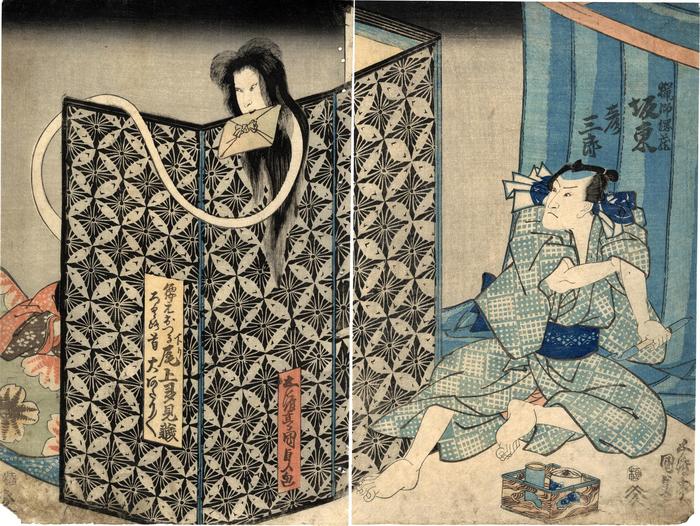Utagawa Kunisada (歌川国貞) / Toyokuni III (三代豊国) (artist 1786 – 01/12/1865)
Bandō Hikosaburō IV (坂東彦三郎) on right as Ryoshi Tsunazō (猟師綱蔵) and Onoe Tamizō II (尾上多見蔵) as a long necked monster disguised as the koshimoto Otsuru ( 腰元おつる) - from the play Kasane Ōgi Chiyo no Matsuwaka (重扇寿松若)
05/05/1841
19 in x 14.188 in (Overall dimensions) color woodblock print
Signed: Gototei Kunisada ga
五渡亭国貞画
Publisher: Yamamotoya Heikichi
(Marks 595 - seal 04-007)
Censor's seal: kiwame
Museum of Fine Arts, Boston - the whole triptych
Waseda University - center panel, i.e., left panel here
Waseda University -right panel
Victoria and Albert Museum - a related 1857 print by Toyokuni III
Nationaal Museum van Wereldculturen, Leiden - a similar Kunisada print probably from the same performance
Waseda University -left panel of the triptych
Royal Museums of Art and History, Belgium (via Cultural Japan) - right-hand panel only The scene being portrayed is The Long-necked Ghost (Rokorokubi Ōatari - ろくろ首大あたり).
There is a similar print to the left-hand panel - probably the middle panel of a triptych - at the Rijksmuseum voor Volkenkunde, Leiden (RV-1327-86).
****
Lafcadio Hearn in his Romance of the Milky Way and other studies and stories wrote in his 1910 edition on pages 95-99: "The etymological meaning of Rokuro-Kubi can scarcely be indicated by an English rendering. The term rokuro is indifferently used to designate many revolving objects - objects as dissimilar as a pulley, a capstan, a windlass, a turning lathe, and a potter's wheel. Such renderings of Rokuro-Kubi as "Whirling-Neck" and "Rotating-Neck" are unsatisfactory; -for the idea which the term suggests to Japanese fancy is that of a neck which revolves, and lengthens or retracts according to the direction of the revolution.... As for the ghostly meaning of the expression, a Rokuro-Kubi is either (1) a person whose neck lengthens prodigiously during sleep, so that the head can wander about in all directions, seeking what it may devour, or (2) a person who is able to detach his or her head, and to rejoin it to the neck afterwards."is usually depicted as a woman; and old books tell us that a woman might become a Rokuro-Kubi without knowing it, -much as a somnambulist walks about while asleep, without being aware of the fact.... The following verses about the Rokuro-Kubi have been selected from a group of twenty in the Kyōka Hyaku-Monogatari: -
Nagaki kami woba
Furi-wakété,
Chi hiro ni nobasu
Rokuro-Kubi kana!
(Oh!... Shaking loose her long hair dis-
shevelled by sleep, the Rokuro-Kubi stretches her neck
to the length of a thousand fathoms!
"Atami naki
Bakémono nari" -to
Rokuro-Kubi,
Mité odorokan
Onoga karada wo
(Will not the Rokuro-Kubi, viewing with
astonishment her body [left behind] cry out,
"Oh, what a heedless goblin have you be-
come!"
Tsuka-no-ma ni
Hari wo tsutawaru
Rokuro-Kubi
Kéta-kéta warau -
Kao no kawasa yo!
(Swiftly gliding along the roof-beam [and
among the props of the roof], the Rokuro-Kubi
laughs with the sound of "kéta-kéta" -oh! the
fearfulness of her face!
Roku shaku no
Byōbu ni nobiru
Rokuro-Kubi
Mité wa, go shaku no
Mi wo chijimi-kéri!
(Beholding the Rokuro-Kubi rise up above the
six-foot screen, any five-foot person would have
been shortened by fear ]or, "the stature of any
person five feet high would have been dimin-
ished."]
Hearn noted that there are too many double-meanings in these poems to list them all. But he did add that 'kéta-kéta' was the sound a ghost would make when laughing or chuckling.
****
In The Encyclopedia of Demons in World Religions and Cultures by Theresa Bane, McFarland and Company, Inc., page 272 it says: "Rokuro-kubi are demonic creatures in Japanese demonology. Thought to have once been humans, through an act of karma they were transformed for their transgressions. Usually appearing as human females by day, at night their faces become horrific and their necks stretch to great lengths or, in some cases, detach from their bodies. Who a rokuro-kubi preys upon varies upon the individual creature s preference; some attack those who broke a particular Buddhist doctrine while others only attack men. At night, the rokuro-kubi s neck elongates or detaches from the body, allowing it to spy on its prey before attacking. As it flies it makes the traditional ghost laughing sound of keta-keta!"
"Tricksters by nature, they are compelled to frighten and spy on humans; these demons feed off life energy and drink lamp oil. Some rokuro-kubi live human lives, keeping their demonic nature a secret. Some revel in their nature, and others are not even aware that they are anything other than human."
****
The linguistics site Jisho.org gives two variant ways of writing the term rokurokubi: ろくろ首 and 轆轤首. While generally this kind of monster is almost exclusively described as resembling a female, there is a Hokusai drawing in the British Museum which shows a male head attached to an inordinately long, twisting neck. It is accompanied by an identifying text in kanj. Their curatorial notes give the title of this piece as Chōjikoku Hitōban, Senrin Rokurokubi Kyōketsukoku (長耳國 飛頭蠻・旋輪 轆轤首 胸穴國). They add a translation: "Land of long ears Flying-head barbarian, rotations Long-neck (potter's-wheel neck) Land of hole-in-the-chest".
Note that a potter's wheel is a rokuro (轆轤).
Yamamotoya Heikichi (山本屋平吉) (publisher)
actor prints (yakusha-e - 役者絵) (genre)
Onoe Tamizō II (二代目尾上多見蔵: 11/1820-1848; 1850-November, 1885) (actor)
Yūrei-zu (幽霊図 - ghosts demons monsters and spirits) (genre)
Bandō Hikosaburō IV (四代目坂東彦三郎: 11/1816 to 2/1856) (actor)
